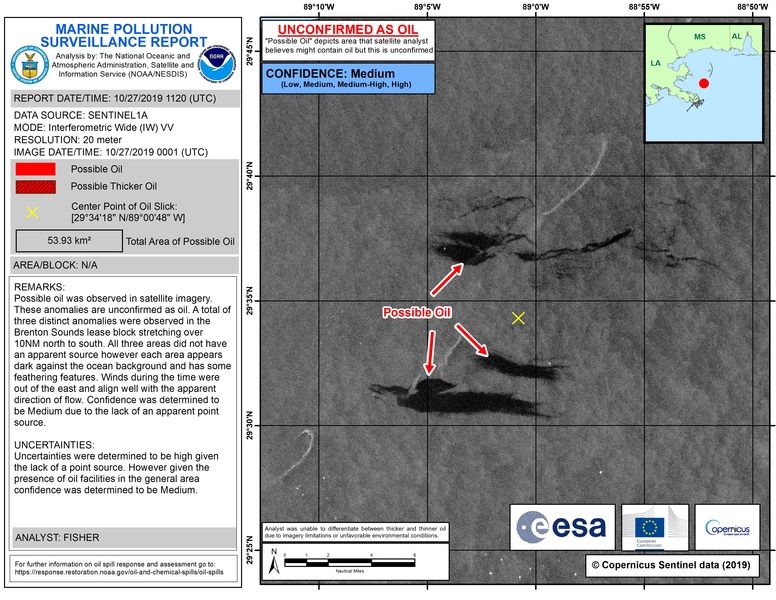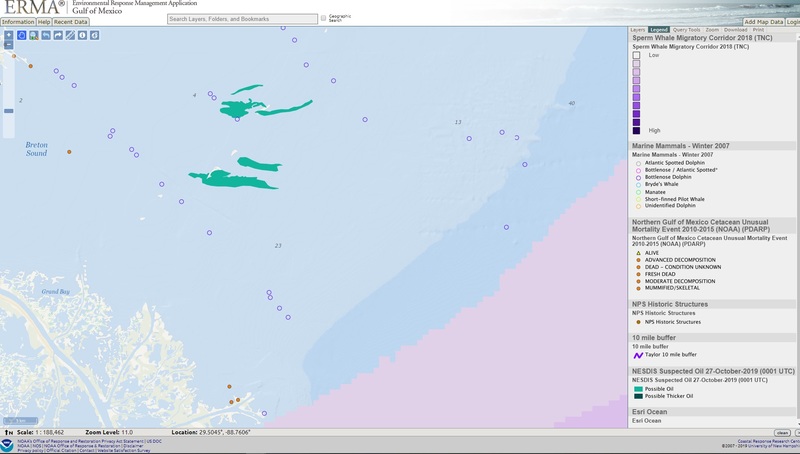Gulf lovers, we have a problem:
The Coast Guard is not reporting any likely gallon estimate of a loss of wellhead control from Sunday night, October 26th, in Breton Sound 37. This gusher is from the Texas Petroleum Investment Company's well. The Coast Guard also isn't discussing the likely environmental impacts as a result of the Oil Spill Pollution Act of 1990, and how oil companies responsible for oil spills litigate against the government under the law.
As advocates, we'd like the news to report the likely damages and amounts, despite the political desires of the industry not to have these discussions in the press. It is what the public expects, although most people don't realize that there are not enough dedicated wildlife observers to document oil spill damages, and that changes what the press reports. It is our job as science advocates to review the public documents and inform the public what they expect to be notified about--that oil spills damage our wildlife, our water, and our fisheries and endangered species. Here's a look into our thought process for an emerging situation.
Original Sentinel photograph, interpreted by NOAA/NESDIS
News articles:
https://www.katc.com/news/covering-louisiana/coast-guard-monitoring-oil-slick-in-breton-sound
https://www.brproud.com/news/coast-guard-local-agencies-respond-to-breton-sound-oil-discharge/
Emergency Information
When we look at the map of Sunday's night's initial report, impacts to bird islands seem likely, as oil sheens appear to cover the smaller, unnamed sand spits north of Breton Island that are regularly colonized by Brown Pelicans, terns, gulls, and other migrating birds.

Figure: an overlay of the NESDIS drawing over a reference aerial photograph of the unnamed islands.
The USCG, vary of being sued by the oil company, doesn't report bird impacts unless they've got a bird survey by an agency who might not exist on scene. The company didn't report any extent, much less any bird impacts, despite the likelihood of oiled wildlife. The media story (and we are lucky there was one) would seem to communicate that there are no environmental impacts. This is distressing to those of us who have seen such impacts regularly go under- and un-reported by our media. What can we say about this event?
Timeline of public information
Advocates in the know can check for public documents shared online.
A timeline of the spill reporting, based on NRC reports, with their Skytruth links, is below.
NRC 1262288 9pm 26th october NESDIS sat photo analysis
https://alerts.skytruth.org/report/0dc2b6b2-d390-30b5-91d3-045542f202ad/
Sentinel on ERMA
https://erma.noaa.gov/gulfofmexico/#/layers=35284+43179&x=-89.04183&y=29.57087&z=12&panel=layer
Sentinel NESDIS analysis can be downloaded.
https://prod-erma-api.orr.noaa.gov/api/v1/data_layer_file/9689/download/
NRC 1262300 8:40 am 27th October 10 miles by 3 miles reported east of the islands.
https://alerts.skytruth.org/report/b80db19a-eecf-552d-813d-8b14f8709f24/
NRC 1262308 noon --south of Breton Island --could the oil have encountered Breton Island, then?
https://alerts.skytruth.org/report/50a42393-b7ae-a285-cb65-a46f3af9aff7/
NRC 1262330 3:30 pm TPIC finally calls it in, no volume estimates of sheen extents. The Press relies on the report from 0840 am.
https://alerts.skytruth.org/report/0f885b82-3eae-36c2-7861-821ee2935b3d/
Tuesday --News reports of USCG monitoring and OMI (a third party contractor with clean up equipment) mobilization efforts, including skimmers. See photographs of such efforts for spills in Jefferson Parish here, and Plaquemines Parish marshes here.

Figure: A time-limited search for NRC reports in the area using the Skytruth system.
By Tuesday, Louisiana Wildlife and Fisheries is on scene, but not NOAA Oil Response, and NOAA Oil Response doesn't seem to have been consulted.
The public has to dig into the reports to produce a simple gallon estimate, or get news about wildlife impacts, because of the litigation chill that oil companies can produce over public information. By Wednesday, advocates only have a snapshot of one day's worth of oil spilled. Advocates also have one report of oily water that has been retrieved. This is often a minute fraction of the oil spilled, but indicates that the oil was thick enough to warrant sending a skimmer vessel. This is impetus enough to produce a conservative (low) estimate of the oil spilled--advocates are also exposed to SLAPP suits by industry, and subject to a general attitude by the press that their information is biased--so caution is useful.
HealthyGulf Estimates
We've learned from the Taylor and BP disasters that our methods usually underestimate the amount of oil spilled per day, but we can usually get within one order of magnitude of the amount. Companies are regularly off by multiple orders of magnitude. We make many conservative assumptions in order to have an estimate the public can roughly understand. This is much better than leaving everyone guessing, or implying that there is no impact.
Using the Bonn convention, we multiply the extent of oiling by a minimum depth for rainbow sheen. The Bonn guideline for rainbow sheen is 0.3 cubic meters per square kilometer. That's 79 gallons per square kilometer. NESDIS reported 53.93 square kilometers of slick on the Sentinel radar image.
Using the polygons from NESDIS snapshot, we load the areas of the sheen into our spreadsheet, complete some conversions from square kilometers to square feet, and we have our estimate---4,260 gallons, or 101 barrels. Again, 53.93 x 79 = 4,260 gallons Given that OMI was using skimmers, this seems very conservative.
Motivating Agencies to fund Wildlife Observations
Having a gallon estimate from independent scientists and advocates can motivate agencies to survey the area for endangered species damages. It is expensive and risky for the government to pay to fly specialists to Breton Sound for an oil spill that may be dispersed by the wind and waves before they arrive.
The Clean Water Act fine per barrel from our estimate would appear to be over $100,000 dollars. USEPA is in charge of such fines, but no one has heard of their response to this incident. But, it can communicate to agencies that they should act, and could cover costs of specialist observers.
But how else can we motivate agencies to send an investigative team? From the record, we can see that Breton Sound is an area where dolphins have been observed (purple circles), and where Sperm Whales are unlikely to travel (pink areas). Other analyses can be produced for Oysters, Redfish, Speckled Trout, and Menhaden. Hint: they are likely impacted.

Figure: Bottlenose Dolphins have been sighted in the precise locations covered in TPIC sheen. Breton Sound is also Essential Habitat for many other species.
Summary, and the Future
The Oil Spill pollution act of 1990 is a powerful tool for recouping the costs of oil production for our natural resources. But in practice, the government lacks the legal and observational capacity to truly document the likely impacts of events like the Texas Petroleum Investment Company's gusher of Oct 26th, 2019. This lack of eyes on the water affects the government's willingness to speak frankly on likely impacts, which changes press reports, and thus the public's impression of what damages oil spills cause, unless they've personally lived through an oiling event.
What fines will be levied against TPIC? What impacts to harvesters were there? are there? Advocates and locals know many stories of oiled areas that will never see print nor twitter feed. It drags on people's faith in their institutions, their faith in the public trust, until it hurts for folks to hope. This event already seems destined to be lost to time, except for the memories of those faithful USCG coasties and OMI workers close enough to smell the oil and stack soiled boom.
As of this writing, October 30th, it is unknown to the public whether this well is under control, although such a small well has hopefully not been a huge problem for OMI, USCG, and Parish responders. With the trickle of information available, knowledgeable advocates can report on likely environmental impacts. But the need for independent observers, trained or untrained, on the water, to protect the water, is apparent to us who care for our future.

3 Comments
Don't convert to square feet. I misunderstood the units.
Reply to this comment...
Log in to comment
I learned so much from this note, thank you @eustatic for your tireless advocacy. Adding a news link: https://www.brproud.com/news/coast-guard-local-agencies-respond-to-breton-sound-oil-discharge/
Reply to this comment...
Log in to comment
well thanks, my point is undercut by the retraction i have to make, so need to include a chapter on how responders don't get enough sleep. it's too much to expect the coast guard to fix the well and survey for wildlife, because you end up making silly mistakes.
Reply to this comment...
Log in to comment
Login to comment.